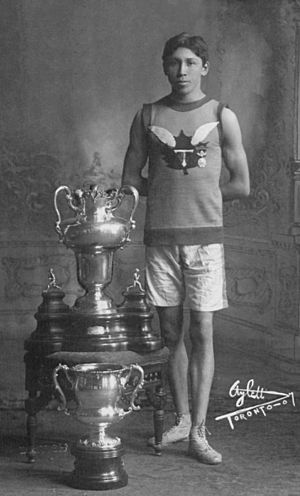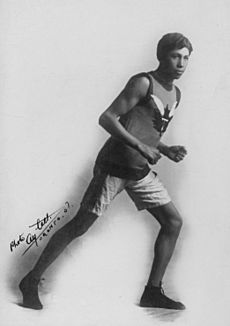Tom Longboat facts for kids

Tom Longboat with the Ward Marathon Trophy in 1907
|
|
| Personal information | |
|---|---|
| Full name | Thomas Charles Longboat |
| Born | July 4, 1886 Six Nations Reserve Brantford, Ontario, Canada |
| Died | January 9, 1949 (aged 62) Six Nations Reserve |
| Height | 1.75 metres (5 ft 9 in) |
| Weight | 66 kilograms (146 lb) |
| Sport | |
| Sport | Running |
| Event(s) | Long-distance |
| Club | Brantford |
Thomas Charles Longboat (born July 4, 1886, died January 9, 1949) was a famous long-distance runner. His Onondaga name was Cogwagee. He came from the Six Nations Reserve in Ontario, Canada. For many years, he was one of the best long-distance runners. People called him the "bulldog of Britannia." He also served as a soldier in World War I.
Contents
Tom Longboat's Running Career
When Tom Longboat was a child, a man named Bill Davis inspired him. Bill Davis, a Mohawk resident from the reserve, finished second in the Boston Marathon in 1901. Tom started racing in 1905. He came in second in the Victoria Day race in Caledonia, Ontario.
Early Victories and Records
His first big win was in 1906. He won the Around the Bay Road Race in Hamilton, Ontario. He finished three minutes ahead of the next runner. In 1907, he won the Boston Marathon. He set a new record time of 2 hours, 24 minutes, and 24 seconds. This was almost five minutes faster than any winner before him.
In the 1908 Olympic Games marathon, Tom Longboat became very tired and collapsed. Many other top runners also had trouble. A new race was set up later that year in New York City. Tom won this race. He then decided to become a professional runner. In 1909, he won the title of Professional Champion of the World. He beat famous runners like Dorando Pietri and Alfred Shrubb.
Training and Challenges
Tom's coaches did not like his training style. He would do hard workouts, then take "active rest" days. This meant long walks instead of intense training. Today, this mix of hard, easy, and recovery days is normal for athletes. But back then, his promoters and the news often called him "lazy." Because of disagreements with his managers, Tom bought out his contract. After this, his running times got even better.
After 1909, Tom started having knee and back problems. Even though people knew about his injuries, some reporters blamed his occasional poor performance on "Indian laziness." His old manager, Tom Flanagan, even spread false rumors that Tom didn't train enough. This made some sportswriters think badly of him.
Tom Longboat's family did not believe how fast he could run. To show them, he once gave his brother a half-hour head start in a horse and buggy. Tom ran on foot, and he still arrived in Hamilton first! His main competitor was Alfred Shrubb. They raced ten times. Tom won all the races that were 20 miles or longer. Alfred won all the shorter races.
Serving in World War I
Tom Longboat served in World War I in France. He was a dispatch runner, carrying messages between military posts. He was hurt twice during his service in Belgium. There were stories that he had been trapped underground by an exploding shell. However, Tom himself said these stories were not true in an interview in 1919. He stopped running professionally after the war.
When Tom was an amateur runner, he only lost three races. One of these was his very first race. By the time he became a professional, he held two national track records. He also had several unofficial world records. As a professional, he set world records for 24 and 32-kilometer races. He almost set a world record for 19 kilometers too.
Tom Longboat's Life Story
Tom Longboat grew up in a family that did not have much money. They lived on a small farm. His father passed away when Tom was only three years old. When he was 12, he had to go to the Mohawk Institute Residential School. This was required by law at the time. He did not like the school. He was pressured to change his Onondaga beliefs to Christianity. He was also expected to stop speaking his language.
Tom tried to escape the school once and failed. He tried again and reached his uncle's home. His uncle kept him hidden from the authorities. After Tom became a famous athlete, the school invited him to speak. He refused, saying, "I wouldn't even send my dog to that place."
In 1908, Tom married Lauretta Maracle. In 1916, he joined the Canadian military. He ran messages between army posts. While he was serving, a man named Edgar Laplante pretended to be him. Laplante was a singer and conman. From late 1916 to mid-1917, he traveled around America. He gave concerts and made money by pretending to be the famous Tom Longboat.
News stories in America reported that Tom Longboat had died in the war. These stories often showed pictures of the imposter, Edgar Laplante. Because people thought Tom was dead, his wife Lauretta remarried in 1918. Tom was happy to be alive, but Lauretta did not want to leave her new husband. Tom later married Martha Silversmith. They had four children together. After the war, Tom lived in Toronto and worked until 1944. He then moved back to the Six Nations Reserve. He passed away on January 9, 1949, from pneumonia.
Tom Longboat's Lasting Legacy
After Tom Longboat died, his rival Alfred Shrubb spoke about him. Shrubb said that Tom was "one of the greatest, if not the greatest marathoner of all time."
Awards and Honors
In 1951, the Tom Longboat Awards were created. This program honors amazing First Nations athletes each year. National male and female winners are chosen from provincial winners. Tom Longboat was added to Canada's Sports Hall of Fame in 1955. He is also in the Ontarian Sports Hall of Fame and the Indian Hall of Fame.
The Toronto Island 10 km race is held every year to remember Tom Longboat. In 1976, he was named a National Historic Person. In 1978, a new school opened in his honor: Tom Longboat Junior Public School.
Tom Longboat was inducted into the Ontario Sports Hall of Fame in 1996. He was the first person of Native American descent to win the Boston Marathon. Only one other Native American, Ellison Brown, has won it since.
Commemorations
On February 17, 2000, Canada Post released a 46-cent postage stamp honoring Tom Longboat. In 2008, a lane in Toronto was officially named Tom Longboat Lane. This lane is south of Longboat Avenue. Also in 2008, June 4th was officially named "Tom Longboat Day" in Ontario.
On June 4, 2018, Google celebrated Tom Longboat's life and legacy. Their special drawing appeared across Canada and the United States. Tom Longboat is also a character in the 2021 film Run Woman Run. He is played by actor Asivak Koostachin. Historica Canada released a Heritage Minute about Tom Longboat on June 4, 2022.
See also
 In Spanish: Tom Longboat para niños
In Spanish: Tom Longboat para niños


